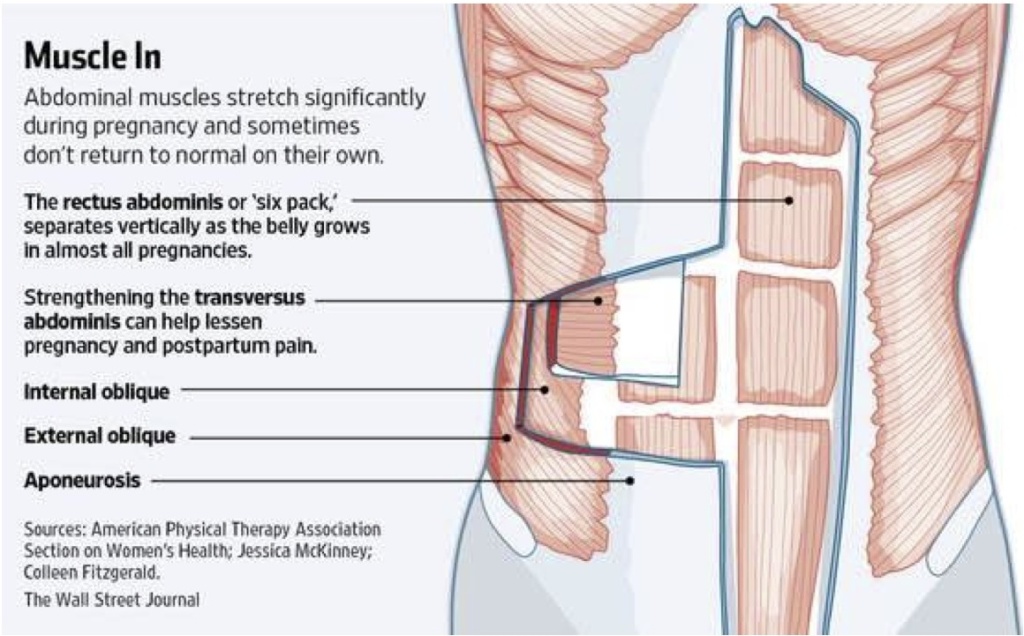Diastasis Recti: Defined
What is this big, scary sounding term and how does it or could it effect you, your pregnancy and ability to recover postpartum? Diastasis Recti is a term for the weakening and subsequent separation of the connective tissue at the midline of the abdomen secondary to increased intra-abdominal pressure. In simple terms, it’s the separation of the “six-pack” muscles laterally from left to right and is a symptom of a core that is not functioning well. This separation is quite common, with some sources citing it’s prevalence in as many as two out of three moms who have had two or more babies. In my experience, it is occurring among plenty of first time moms as well!
Contributing Factors:
Intra-abdominal pressure is increased by the growing uterus and baby, and is then further exacerbated by misalignment, poor breathing habits and improper core exercises during pregnancy. Honestly, we are set up to be misaligned with the conventions of modern life; many of us have a bottom that is firmly planted in a desk chair during the day and then, on a comfy sofa at night, many of us have a tucked pelvis while commuting and contort our feet into heeled shoes for much of the day. Naturally, pregnancy can stand to (and often does) further exacerbate pre-existing misalignment as our body’s ability to compensate is less effective with baby on board.
Along with misalignment, many of us have less than optimal breathing patterns and as women, have a tendency to suck in our stomachs, thereby increasing intra-abdominal pressure further. And we do this… All. Day. Long. These unconscious habits cause subtle, sustained pressure build-up, setting the stage for diastasis to occur when the additional challenge of pregnancy is in place.

We focus on strengthening the deepest layer of muscle, the Transverse Abdominis to help prevent or exacerbate existing diastasis.
Symptoms:
Prenatally, you may see a visible separation at the midline, a dip in your abdomen by your umbilicus, or a “triangle shape”/”peak” when leaning forward. Postpartum, you may see a “pooch”/“mummy tummy,” may experience lower back pain and/or some degree of pelvic floor dysfunction. The majority of women with diastasis also experience some degree of pelvic floor dysfunction. Know that no amount of pelvic floor dysfunction should be considered acceptable or normal!
What to do about it Prenatally?
During pregnancy, simply refrain from those things that make it worse:
1.) Avoid crunches or any core exercises that involve flexion of the spine and utilize the “six-pack” muscles as this will increase intra-abdominal pressure. Practice core exercise that are safe during pregnancy by attending group classes or scheduling a one-on-one to learn more!
2.) Practice proper alignment. Here are a few pointers:
- Starting from the bottom up, the goal is to find a neutral space for your pelvis, spine, your body.
- With feet shoulder width apart, ground through your heels–toes should be able to wiggle.
- Knees are soft, spine and pelvis in neutral–when you are in neutral, you should feel the muscles of your Transverse Abdominus (TVA) flicker to life.
- Ribs and shoulders are dropped down. Do not thrust chest forward.
- Neck is regal and strong, chin parallel to the floor.
- Now, check that ears are over shoulders and shoulders are over hips.
- How do feel? Different? Unnatural perhaps? It’s common to feel a bit awkward initially, but with practice and as muscle memory builds, your body will learn to find this state of neutral alignment.
- Come back to these reminders throughout the day and rehearse over and over and over!
3.) Engage in safe movement throughout activities of daily living, when exercising and with position changes, ie: from a supine or side-lying position, assist self to standing with help of upper body. To do this, stack knees and roll to your side, utilize the strength of your arms while you swing legs to floor and upper body to seated position. Further brace and assist yourself to standing position with help from upper body as opposed to holding your breath and bracing with core to stand.
What to do about it postpartum?
My very best advice is to BE PROACTIVE and to respect your postpartum body. Pay attention to how you feel, to the feedback your body is providing in the initial (and ongoing) postpartum period, take notes and ask your provider to check for diastasis at your follow-up appointment. Then, take it one step further and go see a specialist for another check and to get set-up with a program to begin to rehabilitate your core in a safe and methodical manner.
Return to Fitness!
Many of us want to jump right back into higher intensity exercise and the urge to loose the pregnancy weight is real and understandable. These are all reasonable goals with a thoughtful, individualized approach based on your specific needs. It is important to remember that there is not a “one-size-fits-all” model of postpartum recovery. Your needs will be quite individual based on circumstances of labor and delivery, pre-existing function or dysfunction etc. Set-up an appointment for a one-on-one consultation to assess for diastasis recti and to formulate a plan for recovery.
When working together, you are ALWAYS welcome to bring baby along to your appointment, or I will gladly make a home visit.
Find comfort in knowing that resources are available to help you recover safely and effectively!
[hr]

